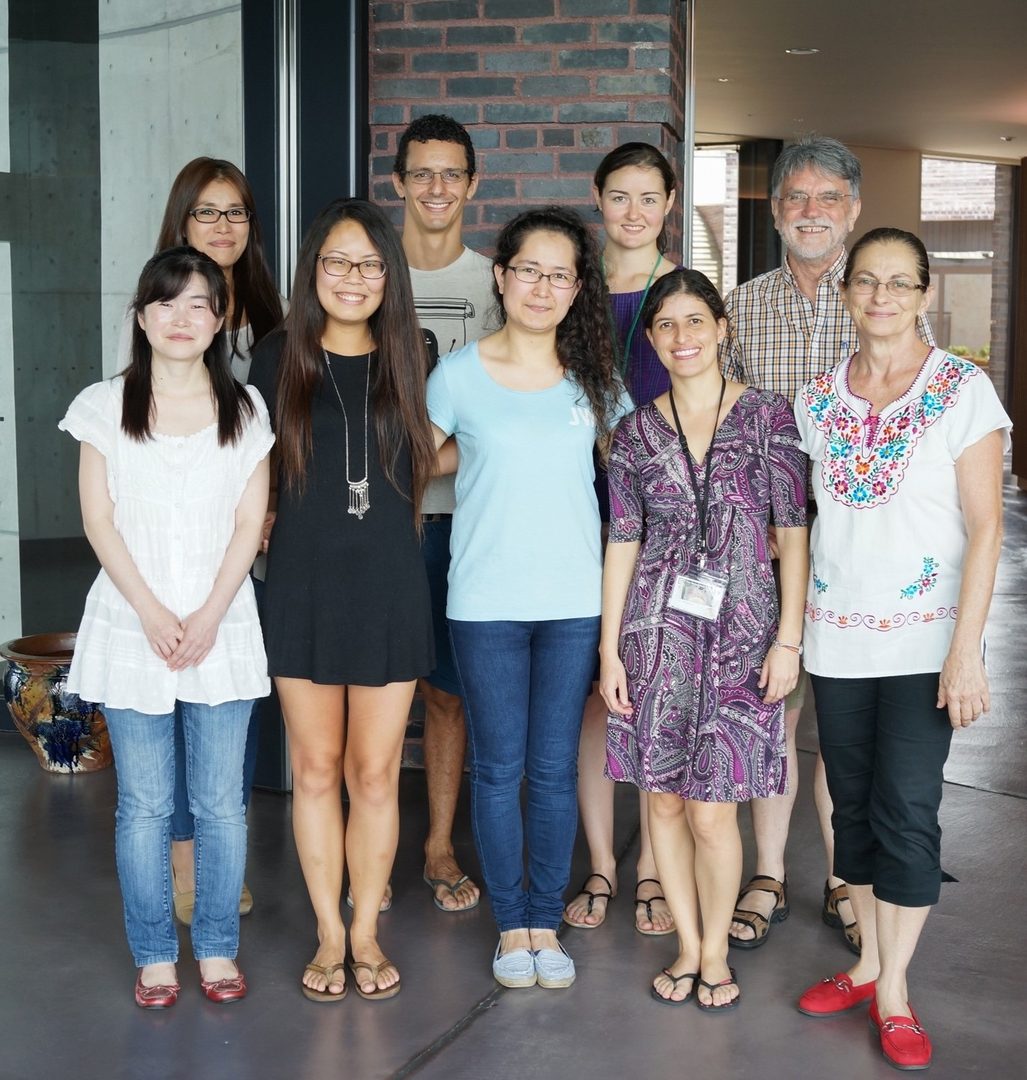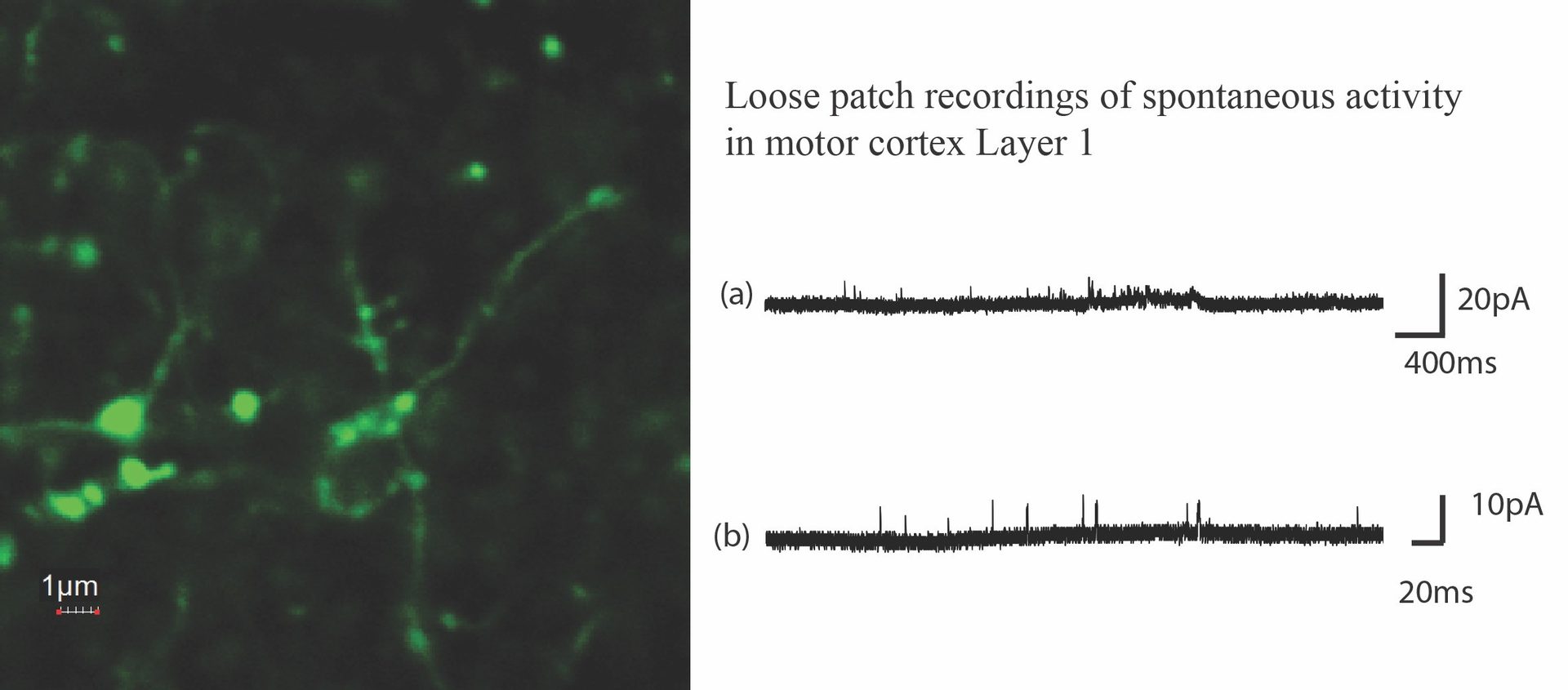FY2015 Annual Report
Brain Mechanism for Behavior Unit
Professor Gordon Arbuthnott

Abstract
Our Unit is committed to the study of brain neuroanatomical, electrophysiological, and behavioural alterations that accompany the loss of the neurotransmitter dopamine in animal models of Parkinson’s disease. In the period between April 2015-2016 thanks to their continuous hard work, commitment and creativity, two postdoctoral scholars from our Unit left to continue their successful scientific careers. Dr. Violeta Gisselle Lopez Huerta was the first to leave to The Broad Institute of MIT and Harvard, followed by Dr. Omar Jáidar who is now at the University of Stanford, School of Medicine, Neurosurgery. We are still keeping in close communication with both of them to finish pending manuscripts. We have seen the arrival of two postdoctoral scholars, Dr. Teresa Hernandez Flores and Dr. Emmanuelle Sandrine Albert. They have started challenging single cell recording experiments and neuronal calcium imaging in CRE animals expressing various viruses. Ms. Yoko Nakano our research technician, continues supporting our group’s productivity, especially in immunohistochemistry and production of viral vectors as well as genotyping the transgenic animal colonies. Dr. Marianela Garcia Munoz, our senior group leader, manages and supervises the research team, more so now that Prof. Arbuthnott, the head of the Unit, was appointed Dean of Faculty Affairs. She directly works with neuronal cultures and oversees research projects and publications. She is not only an experienced advisor for postdoctoral scholars, but also a leader for our graduate students: Nilupaer Abudukeyoumu and Bianca Sieveritz. From their first day, these students have worked remarkably hard. They are learning to be scientists who constantly explore and discuss the literature, propose creative ideas and perform very high standard experimental work with excellent self-demanding quality control. Resulting from a collaboration with Dr. Luoise Parr-Brownlie of the University of Otago, New Zealand (see bellow), Ms. Nikki Guy successfully finished almost a year-long research collaboration; returned to New Zealand and obtained her master’s degree there. Ms. Rebecca Yang as an intern in the Unit, learned how to handle and train mice in a 5-choice serial reaction time. The purpose of her work was to explore previous casual observations that not all mice from Dadr1, Dadr2 and C57BL/6J strains learned the task equally. Indeed, she observed that learning and performance were worst in Dadr2 mice, however, we estimate that training for a much longer period should be performed before publishing any results.
1. Staff
- Dr. Marianela Garcia-Munoz, Group Leader
- Dr. Teresa Hernandez Flores, Researcher
- Emmanuelle Sandrine Albert, Researcher
- Yoko Nakano, Technical Staff
- Nilupaer Abudukeyoumu, Graduate Student
- Bianca Sieveritz, Graduate Student
- Hiroko Chinone, Administrative Assistant
2. Collaborations
2.1 Cerebellar afferents to motor thalamus
- Description: Nikki Guy did most of her M.Sc. research in the Unit.
- Type of collaboration: Joint research
- Researchers:
- Dr. Louise Parr-Brownlie, University of Otago, New Zealand
2.2 Activity of motor cortex in Parkinson’s disease
- Description: After data gathering, manuscript is in process.
- Type of collaboration: Joint research
- Researchers:
- Professor Wing Ho Yung, Hong Kong Chinese University
2.3 Thalamic input to cortex
- Description: Activity of thalamocortical afferents studied in awake freely-moving mice
- Type of collaboration: Joint research
- Researchers:
- Professor Bernd Kuhn, OIST Graduate University
2.4 Optical probe for deep brain recordings
- Description: Research work on optical probe by graduate student Mr. Simon Peter Mekhail
- Type of collaboration: Joint research
- Researchers:
- Professor Sile Nic Shormaic, OIST Graduate University
3. Activities and Findings
3.1 Subsection Title If Necessary
We were pleased to see our previous postdoctoral fellows mature to become bright independent scientists. With our two newly arrived postdoctoral scholars, we are now embarking onto a new scientific adventure to further clarify alterations in motor cortex resulting from dopamine depletions in animal models of Parkinson disease.
Teresa Hernandez is exploring and refining previous findings from her predecessors and proposing interesting hypothesis about thalamo-cortical motor function. During his last project at OIST, Omar Jáidar observed in collaboration with Prof. Bernd Kuhn (Optical Neuroimaging Unit), that viral injections in motor thalamus allowed identification of active terminal axon fibres and varicosities in layer 1 of frontal cortical areas. Now, Teresa Hernandez is focusing on activity changes in all layers of motor cortex (Figures 1 and 2). She is doing calcium imaging combined with patch-clamp recordings.

Figure 1: Sagittal section of the motor cortex of a C57BL/6J mouse expressing the ultra-sensitive green fluorescent genetically encoded calcium indicator (GCaMP6f) two weeks after stereotaxic injection of AAV-1- GCaMP6f. The approximate location of cortical layers 1, 2-3 and 5 is indicated on the left.

Figure 2:
Calcium imaging of neuronal activity in motor cortex
- Schematic of motor cortex injection of AAV1- GCaMP6f into a mouse brain.
- Photomicrographs of the brain sagittal slice ready for recordings. Left. Optical field 10X, infrared light image of region of interest. Right. Fluorescence image of the same slice seen on the left obtained two weeks after injection. Scale bar 100µm.
- Data analysis of neuronal activity revealed by the calcium sensor gCamP6f. Top: Raster plot represents for each row, an individually identified neuron (Y axis) as it becomes active along the 6 min recording (X axis). Bottom: Histogram to illustrate peaks of coactivity.
Sandrine Albert has devoted her attention to specific activity changes in synaptic varicosities of layer 1 (Figures 3 and 4). She is transferring her expertise on retina ganglion cells to the delicate recordings in layer 1. In general, she would like to focus on the role of layer 1 as a driving force and regulatory entity of pyramidal cell excitability in motor cortex and determine if layer 1 provides a restricted, wide-range or both types of influence on cortical activity.

Figure 3: Single photon photomicrograph (60X). Sagittal section of the motor cortex layer 1 from a C57BL/6J mouse expressing AAV-1- GCaMP6f.

Figure 4. Challenging recordings of axons and varicosities in cortical layer 1. Left, low magnification image of axons and terminals. Visualization of fine processes for electrode placement, required that the initial image (left) be further magnified 8 more times (60X 8). Traces on the right are loose patch records of boutons (a) and axons (b).
4. Publications
4.1 Journals.
- Carrillo-Reid L, Lopez-Huerta VG, Garcia-Munoz M, Theiss S, Arbuthnott GW (2015) Cell Assembly Signatures Defined by Short-Term Synaptic Plasticity in Cortical Networks. International Journal of Neural Systems, 25:1550026. DOI 10.1142/S0129065715500264.
- Garcia-Munoz M, Arbuthnott GW (2015) Basal ganglia-thalamus and the "crowning enigma". Frontiers in neural circuits 9:71. DOI 10.3389/fncir.2015.00071.
- Garcia Munoz M, Taillefer E, Pnini R, Vickers C, Miller J, Arbuthnott GW (2015) Rebuilding a realistic corticostriatal “socialnetwork” from dissociated cells. Front Syst Neurosci 9: Article 63. DOI 10.3389/fnsys.2015.00063.
- Hikima T, Garcia-Munoz M, Arbuthnott GW (2016) Presynaptic D1 heteroreceptors and mGlu autoreceptors act at individual cortical release sites to modify glutamate release. Brain research 1639:74-87. DOI 10.1016/j.brainres.2016.02.042.
- Lopez-Huerta VG, Nakano Y, Bausenwein J, Jaidar O.Lazarus M, Cherasse Y,Garcia-Munoz M, Arbuthnott G. (2016). "The neostriatum: two entities, one structure?" Brain Struct Funct 221(3): 1737-1749. (electronic version ahead of print)
4.2 Books and other one-time publications
Nothing to report
4.3 Oral and Poster Presentations
- N. Abudukeyoumu, O. Jáidar, Y. Nakano, M. Garcia-Munoz, G.W. Arbuthnott Cholinergic interneuron sprouting in striatum, British Neuroscience Association Festival of Neuroscience, Edinburgh, Scotland, April 11, 2015
- O. Jaidar, C. J. Roome, Y. Nakano, M. Garcia-Munoz, B. Kuhn, G.W. Arbuthnott, Thalamocortical axons and deep cortical layer I dentritic arbor in motor cortex., British Neuroscience Association Festival of Neuroscience, Edinburgh, Scotland, April 11, 2015
- V.G. Lopez-Huerta, Y. Nakano, J. Bausenwein, O. Jaidar, M.Lazarus, Y. Cherasse, M.Garcia-Munoz, G. W. Arbuthnott., The Neostriatum: two neuronal networks without direct interaction., British Neuroscience Association Festival of Neuroscience, Edinburgh, Scotland, Apirl 12, 2015
- G.W. Arbuthnott Is it time to scrap the 'standard model' of the basal ganglia? Some thoughts about how brains control of movement/behavior., British Neuroscience Association Festival of Neuroscience, Edinburgh, Scotland, April 17, 2015
- G.W. Arbuthnott Some Worries – or Excitement – about How the Basal Ganglia System is –or is NOT - Organized, Asia-Pacific International Congress on Engineering and Natural Sciences, Okinawa, Japan, July 30, 2015
- G.W. Arbuthnott, M. Garcia-Munoz, L. Carrillo-Reid, O.Jaidar, J. Bargas, V. Lopez-Huerta. Patterns of neuronal activity in the absence of external input, The 6th Federation of Asian and Oceanian Neuroscience Societies Congress and 11th Biennial Conference of the Chinese Neuroscience Society, Wuzhen, Zhejiang, China, September 22, 2015
- Q.Li, H. Ko, D. Chan, G.W. Arbuthnott, Y.Ke, W. Yung Neuronal ensemble dynamics in layer 5b of primary motor cortex during motor learning, Society for Neuroscience, Chicago, IL, U.S.A., October 21, 2015
- O.P. Jaidar, C.J. Roome, M. Garcia-Munoz, Y. Nakano, B. Kuhn, G.W. Arbuthnott In vivo study of thalamic axonal dynamics in layer 1 of mice motor cortex, Society for Neuroscience, Chicago, IL, U.S.A., October 21, 2015
- V.G.Lopez Huerta, Y. Nakano, M. Garcia-Munoz and G.W. Arbuthnott Plasticity in collateral connectivity of striatal projection neurons follows learning of a skilled motor task, Society for Neuroscience, IL, U.S.A., October 21, 2015
- B. Sieveritz, O. Jáidar,M. Garcia-Munoz, G.W. Arbuthnott Thalamic input to prefrontal cortical areas: a retrograde tracing study, Gordon Research Conference, Ventura, CA, U.S.A., Febuary 9, 2016
5. Intellectual Property Rights and Other Specific Achievements
Nothing to report
6. Meetings and Events
6.1 The pathophysiological signatures of functional connectomics in the striatal microcircuit.
- Date: November 10-12, 2015
- Venue: OIST Campus Lab1
- Speaker: Professor José Bargas Díaz, Institute of Cellular Physiology, Universidad Nacional Autónoma de México
6.2 Intrinsic properties of striatal neurons determine similar corticostriatal and thalamostriatal postsynaptic suprathreshold responses.
- Date: November 10-12, 2015
- Venue: OIST Campus Lab1
- Speaker: Professor Elvira Galarraga Palacio, Institute of Cellular Physiology, Universidad Nacional Autónoma de México
7. Other
Nothing to report.



